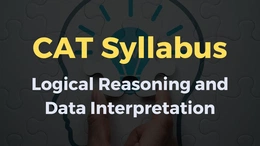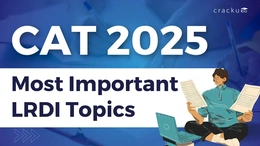25+ Most Important DILR Sets for CAT 2025
In this blog, we’ll cover 25+ important DILR (Data Interpretation and Logical Reasoning) sets for CAT 2025. DILR is one of the toughest sections in the CAT exam, and performing well here can make a big difference to your overall score. In this post, we’ll not only talk about the most expected sets but also provide you with practical sets to improve your skills. Whether you’re just starting your preparation or are already at an advanced level, this guide will give you the right practice to succeed in DILR for CAT 2025.
Download 25+ Most Expected DILR Sets PDF
We’ve created a list of 25+ most expected DILR sets, based on the latest trends and patterns from past CAT exams. These sets cover different topics and difficulty levels, so you’ll be ready for anything. Download the full PDF to practice with the most important sets for CAT 2025 and improve your problem-solving skills.
List of DILR Sets & Questions
In this section, we’ll share some of the most important DILR sets for you to practice. These sets are similar to the types of questions you’ll face in CAT 2025. Along with the sets, we’ve included specific questions to help you improve your skills and build your confidence.
Faculty members in a management school can belong to one of four departments - Finance and Accounting (F&A;), Marketing and Strategy (M&S;), Operations and Quants (O&Q;) and Behaviour and Human Resources (B&H;). The numbers of faculty members in F&A;, M&S;, O&Q; and B&H; departments are 9, 7, 5 and 3 respectively.
Prof. Pakrasi, Prof. Qureshi, Prof. Ramaswamy and Prof. Samuel are four members of the school's faculty who were candidates for the post of the Dean of the school. Only one of the candidates was from O&Q.;
Every faculty member, including the four candidates, voted for the post. In each department, all the faculty members who were not candidates voted for the same candidate. The rules for the election are listed below.
1. There cannot be more than two candidates from a single department.
2. A candidate cannot vote for himself/herself.
3. Faculty members cannot vote for a candidate from their own department.
After the election, it was observed that Prof. Pakrasi received 3 votes, Prof. Qureshi received 14 votes, Prof. Ramaswamy received 6 votes and Prof. Samuel received 1 vote. Prof. Pakrasi voted for Prof. Ramaswamy, Prof. Qureshi for Prof. Samuel, Prof. Ramaswamy for Prof. Qureshi and Prof. Samuel for Prof. Pakrasi.
Question 1
Which two candidates can belong to the same department?
correct answer:- 1
Faculty members in a management school can belong to one of four departments - Finance and Accounting (F&A;), Marketing and Strategy (M&S;), Operations and Quants (O&Q;) and Behaviour and Human Resources (B&H;). The numbers of faculty members in F&A;, M&S;, O&Q; and B&H; departments are 9, 7, 5 and 3 respectively.
Prof. Pakrasi, Prof. Qureshi, Prof. Ramaswamy and Prof. Samuel are four members of the school's faculty who were candidates for the post of the Dean of the school. Only one of the candidates was from O&Q.;
Every faculty member, including the four candidates, voted for the post. In each department, all the faculty members who were not candidates voted for the same candidate. The rules for the election are listed below.
1. There cannot be more than two candidates from a single department.
2. A candidate cannot vote for himself/herself.
3. Faculty members cannot vote for a candidate from their own department.
After the election, it was observed that Prof. Pakrasi received 3 votes, Prof. Qureshi received 14 votes, Prof. Ramaswamy received 6 votes and Prof. Samuel received 1 vote. Prof. Pakrasi voted for Prof. Ramaswamy, Prof. Qureshi for Prof. Samuel, Prof. Ramaswamy for Prof. Qureshi and Prof. Samuel for Prof. Pakrasi.
Question 2
Which of the following can be the number of votes that Prof. Qureshi received from a single department?
correct answer:- 4
Faculty members in a management school can belong to one of four departments - Finance and Accounting (F&A;), Marketing and Strategy (M&S;), Operations and Quants (O&Q;) and Behaviour and Human Resources (B&H;). The numbers of faculty members in F&A;, M&S;, O&Q; and B&H; departments are 9, 7, 5 and 3 respectively.
Prof. Pakrasi, Prof. Qureshi, Prof. Ramaswamy and Prof. Samuel are four members of the school's faculty who were candidates for the post of the Dean of the school. Only one of the candidates was from O&Q.;
Every faculty member, including the four candidates, voted for the post. In each department, all the faculty members who were not candidates voted for the same candidate. The rules for the election are listed below.
1. There cannot be more than two candidates from a single department.
2. A candidate cannot vote for himself/herself.
3. Faculty members cannot vote for a candidate from their own department.
After the election, it was observed that Prof. Pakrasi received 3 votes, Prof. Qureshi received 14 votes, Prof. Ramaswamy received 6 votes and Prof. Samuel received 1 vote. Prof. Pakrasi voted for Prof. Ramaswamy, Prof. Qureshi for Prof. Samuel, Prof. Ramaswamy for Prof. Qureshi and Prof. Samuel for Prof. Pakrasi.
Question 3
If Prof. Samuel belongs to B&H;, which of the following statements is/are true?
Statement A: Prof. Pakrasi belongs to M&S.;
Statement B: Prof. Ramaswamy belongs to O&Q;
correct answer:- 4
Faculty members in a management school can belong to one of four departments - Finance and Accounting (F&A;), Marketing and Strategy (M&S;), Operations and Quants (O&Q;) and Behaviour and Human Resources (B&H;). The numbers of faculty members in F&A;, M&S;, O&Q; and B&H; departments are 9, 7, 5 and 3 respectively.
Prof. Pakrasi, Prof. Qureshi, Prof. Ramaswamy and Prof. Samuel are four members of the school's faculty who were candidates for the post of the Dean of the school. Only one of the candidates was from O&Q.;
Every faculty member, including the four candidates, voted for the post. In each department, all the faculty members who were not candidates voted for the same candidate. The rules for the election are listed below.
1. There cannot be more than two candidates from a single department.
2. A candidate cannot vote for himself/herself.
3. Faculty members cannot vote for a candidate from their own department.
After the election, it was observed that Prof. Pakrasi received 3 votes, Prof. Qureshi received 14 votes, Prof. Ramaswamy received 6 votes and Prof. Samuel received 1 vote. Prof. Pakrasi voted for Prof. Ramaswamy, Prof. Qureshi for Prof. Samuel, Prof. Ramaswamy for Prof. Qureshi and Prof. Samuel for Prof. Pakrasi.
Question 4
What best can be concluded about the candidate from O&Q;?
correct answer:- 2
Faculty members in a management school can belong to one of four departments - Finance and Accounting (F&A;), Marketing and Strategy (M&S;), Operations and Quants (O&Q;) and Behaviour and Human Resources (B&H;). The numbers of faculty members in F&A;, M&S;, O&Q; and B&H; departments are 9, 7, 5 and 3 respectively.
Prof. Pakrasi, Prof. Qureshi, Prof. Ramaswamy and Prof. Samuel are four members of the school's faculty who were candidates for the post of the Dean of the school. Only one of the candidates was from O&Q.;
Every faculty member, including the four candidates, voted for the post. In each department, all the faculty members who were not candidates voted for the same candidate. The rules for the election are listed below.
1. There cannot be more than two candidates from a single department.
2. A candidate cannot vote for himself/herself.
3. Faculty members cannot vote for a candidate from their own department.
After the election, it was observed that Prof. Pakrasi received 3 votes, Prof. Qureshi received 14 votes, Prof. Ramaswamy received 6 votes and Prof. Samuel received 1 vote. Prof. Pakrasi voted for Prof. Ramaswamy, Prof. Qureshi for Prof. Samuel, Prof. Ramaswamy for Prof. Qureshi and Prof. Samuel for Prof. Pakrasi.
Question 5
Which of the following statements is/are true?
Statement A: Non-candidates from M&S; voted for Prof. Qureshi.
Statement B: Non-candidates from F&A; voted for Prof. Qureshi.
correct answer:- 2
A visa processing office (VPO) accepts visa applications in four categories - US, UK, Schengen, and Others. The applications are scheduled for processing in twenty 15- minute slots starting at 9:00 am and ending at 2:00 pm. Ten applications are scheduled in each slot.
There are ten counters in the office, four dedicated to US applications, and two each for UK applications, Schengen applications and Others applications. Applicants are called in for processing sequentially on a first-come-first-served basis whenever a counter gets freed for their category. The processing time for an application is the same within each category. But it may vary across the categories. Each US and UK application requires 10 minutes of processing time. Depending on the number of applications in a category and time required to process an application for that category, it is possible that an applicant for a slot may be processed later.
On a particular day, Ira, Vijay and Nandini were scheduled for Schengen visa processing in that order. They had a 9:15 am slot but entered the VPO at 9:20 am. When they entered the office, exactly six out of the ten counters were either processing applications, or had finished processing one and ready to start processing the next.
Mahira and Osman were scheduled in the 9:30 am slot on that day for visa processing in the Others category.
The following additional information is known about that day.
1. All slots were full.
2. The number of US applications was the same in all the slots. The same was true for the other three categories.
3. 50% of the applications were US applications.
4. All applicants except Ira, Vijay and Nandini arrived on time.
5. Vijay was called to a counter at 9:25 am.
Question 6
How many UK applications were scheduled on that day?
correct answer:- 0
A visa processing office (VPO) accepts visa applications in four categories - US, UK, Schengen, and Others. The applications are scheduled for processing in twenty 15- minute slots starting at 9:00 am and ending at 2:00 pm. Ten applications are scheduled in each slot.
There are ten counters in the office, four dedicated to US applications, and two each for UK applications, Schengen applications and Others applications. Applicants are called in for processing sequentially on a first-come-first-served basis whenever a counter gets freed for their category. The processing time for an application is the same within each category. But it may vary across the categories. Each US and UK application requires 10 minutes of processing time. Depending on the number of applications in a category and time required to process an application for that category, it is possible that an applicant for a slot may be processed later.
On a particular day, Ira, Vijay and Nandini were scheduled for Schengen visa processing in that order. They had a 9:15 am slot but entered the VPO at 9:20 am. When they entered the office, exactly six out of the ten counters were either processing applications, or had finished processing one and ready to start processing the next.
Mahira and Osman were scheduled in the 9:30 am slot on that day for visa processing in the Others category.
The following additional information is known about that day.
1. All slots were full.
2. The number of US applications was the same in all the slots. The same was true for the other three categories.
3. 50% of the applications were US applications.
4. All applicants except Ira, Vijay and Nandini arrived on time.
5. Vijay was called to a counter at 9:25 am.
Question 7
What is the maximum possible value of the total time (in minutes, nearest to its integer value) required to process all applications in the Others category on that day?
correct answer:- 200
A visa processing office (VPO) accepts visa applications in four categories - US, UK, Schengen, and Others. The applications are scheduled for processing in twenty 15- minute slots starting at 9:00 am and ending at 2:00 pm. Ten applications are scheduled in each slot.
There are ten counters in the office, four dedicated to US applications, and two each for UK applications, Schengen applications and Others applications. Applicants are called in for processing sequentially on a first-come-first-served basis whenever a counter gets freed for their category. The processing time for an application is the same within each category. But it may vary across the categories. Each US and UK application requires 10 minutes of processing time. Depending on the number of applications in a category and time required to process an application for that category, it is possible that an applicant for a slot may be processed later.
On a particular day, Ira, Vijay and Nandini were scheduled for Schengen visa processing in that order. They had a 9:15 am slot but entered the VPO at 9:20 am. When they entered the office, exactly six out of the ten counters were either processing applications, or had finished processing one and ready to start processing the next.
Mahira and Osman were scheduled in the 9:30 am slot on that day for visa processing in the Others category.
The following additional information is known about that day.
1. All slots were full.
2. The number of US applications was the same in all the slots. The same was true for the other three categories.
3. 50% of the applications were US applications.
4. All applicants except Ira, Vijay and Nandini arrived on time.
5. Vijay was called to a counter at 9:25 am.
Question 8
Which of the following is the closest to the time when Nandini’s application process got over?
correct answer:- 4
A visa processing office (VPO) accepts visa applications in four categories - US, UK, Schengen, and Others. The applications are scheduled for processing in twenty 15- minute slots starting at 9:00 am and ending at 2:00 pm. Ten applications are scheduled in each slot.
There are ten counters in the office, four dedicated to US applications, and two each for UK applications, Schengen applications and Others applications. Applicants are called in for processing sequentially on a first-come-first-served basis whenever a counter gets freed for their category. The processing time for an application is the same within each category. But it may vary across the categories. Each US and UK application requires 10 minutes of processing time. Depending on the number of applications in a category and time required to process an application for that category, it is possible that an applicant for a slot may be processed later.
On a particular day, Ira, Vijay and Nandini were scheduled for Schengen visa processing in that order. They had a 9:15 am slot but entered the VPO at 9:20 am. When they entered the office, exactly six out of the ten counters were either processing applications, or had finished processing one and ready to start processing the next.
Mahira and Osman were scheduled in the 9:30 am slot on that day for visa processing in the Others category.
The following additional information is known about that day.
1. All slots were full.
2. The number of US applications was the same in all the slots. The same was true for the other three categories.
3. 50% of the applications were US applications.
4. All applicants except Ira, Vijay and Nandini arrived on time.
5. Vijay was called to a counter at 9:25 am.
Question 9
Which of the following statements is false?
correct answer:- 2
A visa processing office (VPO) accepts visa applications in four categories - US, UK, Schengen, and Others. The applications are scheduled for processing in twenty 15- minute slots starting at 9:00 am and ending at 2:00 pm. Ten applications are scheduled in each slot.
There are ten counters in the office, four dedicated to US applications, and two each for UK applications, Schengen applications and Others applications. Applicants are called in for processing sequentially on a first-come-first-served basis whenever a counter gets freed for their category. The processing time for an application is the same within each category. But it may vary across the categories. Each US and UK application requires 10 minutes of processing time. Depending on the number of applications in a category and time required to process an application for that category, it is possible that an applicant for a slot may be processed later.
On a particular day, Ira, Vijay and Nandini were scheduled for Schengen visa processing in that order. They had a 9:15 am slot but entered the VPO at 9:20 am. When they entered the office, exactly six out of the ten counters were either processing applications, or had finished processing one and ready to start processing the next.
Mahira and Osman were scheduled in the 9:30 am slot on that day for visa processing in the Others category.
The following additional information is known about that day.
1. All slots were full.
2. The number of US applications was the same in all the slots. The same was true for the other three categories.
3. 50% of the applications were US applications.
4. All applicants except Ira, Vijay and Nandini arrived on time.
5. Vijay was called to a counter at 9:25 am.
Question 10
When did the application processing for all US applicants get over on that day?
Tips to Improve Your DILR Skills for CAT 2025
Improving your DILR skills requires regular practice, smart strategies, and focus. To do well in this section of CAT 2025, it’s important to understand the types of questions and work on solving them faster. Here are some tips to help you improve:
- Master the Basics: Build a strong understanding of basic data interpretation and logical reasoning concepts. This will make it easier to tackle more difficult sets later.
- Practice Often: The more you practice, the better you’ll get. Try solving different types of DILR sets to get used to different question formats and difficulty levels.
- Manage Your Time: DILR questions can take time, so practice solving them under time limits to improve both your speed and accuracy.
- Identify Patterns: Look for common question types that appear in previous CAT exams. Recognizing these patterns will help you solve similar questions faster.
- Learn from Mistakes: After solving each set, go over your mistakes. Understanding what went wrong will help you avoid making the same errors in the future.
- Use Shortcuts: Learn tricks and shortcuts that can save time while solving questions, especially for calculations and logical reasoning.
- Stay Calm in the Exam: CAT can be stressful, but staying calm is key. Practice under exam conditions to build mental strength and stay focused during the test.
25+ Most Important DILR Sets for CAT 2025: Conclusion
To do well in the DILR section of CAT 2025, regular practice is key. By solving 25+ carefully chosen DILR sets, you’ll become familiar with different types of questions and difficulty levels, which will improve your problem-solving skills. Focus on building a strong understanding of data interpretation and logical reasoning to handle even the toughest questions.
Along with practice, using smart strategies like managing your time well and learning from your mistakes will help you improve. Whether you're a beginner or more advanced, mastering these DILR skills will give you a big advantage in CAT 2025.
correct answer:- 1






















